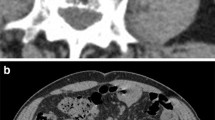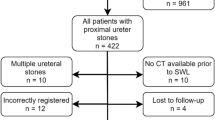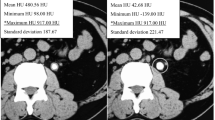Abstract
Purpose
We investigated the clinical efficacy of the Triple D score (TrD-S) on stone-free rate (SFR) prediction following shockwave lithotripsy (SWL) for renal stones 10–20 mm in diameter and modified the scoring system to improve outcome prediction.
Methods
We retrospectively examined clinical data from the medical records of 226 consecutive patients who underwent SWL for 10–20 mm kidney stones. The TrD-S was calculated according to the cutoffs of < 150 mm3 for stone volume, < 600 Hounsfield unit for stone density, and < 12 cm for skin-to-stone distance on computed tomography. The Quadruple D score was defined as the sum of the TrD-S and stone location (0/1 point for intrarenal stone distribution at lower/non-lower poles, respectively). Complete clearance 3 months after the final SWL was considered the stone-free status.
Results
The residual group (n = 102) had significantly older age, larger stones, higher stone density, higher lower-pole stone incidence, and lower TrD-S than the stone-free group (n = 124). In the multivariate analysis, age, TrD-S, and non-lower-pole stones independently predicted the SFR. The TrD-Ss of 0, 1, 2, and 3 points showed SFRs of 40.0%, 51.9%, 73.0%, and 100.0%, respectively. The Quadruple D scores of 0, 1, 2, 3, and 4 points showed SFRs of 0.0%, 37.9%, 54.5%, 84.4%, and 100.0%, respectively, with better prediction accuracy than the TrD-S (p = 0.01).
Conclusions
The TrD-S is successfully validated for use in Japanese patients with 10–20-mm renal stones. Simple addition of the stone location to the TrD-S could reinforce SFR prediction after SWL.

Similar content being viewed by others
References
Turk C, Petrik A, Sarica K et al (2016) EAU guidelines on interventional treatment for urolithiasis. Eur Urol 69(3):475–482
Assimos D, Krambeck A, Miller NL et al (2016) Surgical management of stones: American Urological Association/Endourological Society guideline, PART II. J Urol 196(4):1161–1169
Kanao K, Nakashima J, Nakagawa K et al (2006) Preoperative nomograms for predicting stone-free rate after extracorporeal shock wave lithotripsy. J Urol 176(4 Pt 1):1453–1456
Leavitt D, de la Rosette J, Hoenig D (2016) Strategies for nonmedical management of upper urinary tract calculi. In: Wein A, Kavoussi L, Partin A, Peters C (eds) Campbell-Walsh’s urology. Elsevier, Philadelphia, pp 1235–1259
Dretler SP (1988) Stone fragility—a new therapeutic distinction. J Urol 139(5):1124–1127
Ringdén I, Tiselius HG (2007) Composition and clinically determined hardness of urinary tract stones. Scand J Urol Nephrol 41(4):316–323
Pareek G, Armenakas NA, Fracchia JA (2003) Hounsfield units on computerized tomography predict stone-free rates after extracorporeal shock wave lithotripsy. J Urol 169(5):1679–1681
Pareek G, Hedican SP, Lee FT Jr, Nakada SY (2005) Shock wave lithotripsy success determined by skin-to-stone distance on computed tomography. Urology 66(5):941–944
Ng CF, Siu DY, Wong A, Goggins W, Chan ES, Wong KT (2009) Development of a scoring system from noncontrast computerized tomography measurements to improve the selection of upper ureteral stone for extracorporeal shock wave lithotripsy. J Urol 181(3):1151–1157
Pareek G, Armenakas NA, Panagopoulos G, Bruno JJ, Fracchia JA (2005) Extracorporeal shock wave lithotripsy success based on body mass index and Hounsfield units. Urology 65(1):33–36
Madbouly K, El-Tiraifi AM, Seida M, El-Faqih SR, Atassi R, Talic RF (2005) Slow versus fast shock wave lithotripsy rate for urolithiasis: a prospective randomized study. J Urol 173(1):127–130
Vakalopoulos I (2009) Development of a mathematical model to predict extracorporeal shockwave lithotripsy outcome. J Endourol 23(6):891–897
Wiesenthal JD, Ghiculete D, Ray AA, Honey RJ, Pace KT (2011) A clinical nomogram to predict the successful shock wave lithotripsy of renal and ureteral calculi. J Urol 186(2):556–562
Tran TY, McGillen K, Cone EB, Pareek G (2015) Triple D Score is a reportable predictor of shockwave lithotripsy stone-free rates. J Endourol 29(2):226–230
Kim JK, Ha SB, Jeon CH et al (2016) Clinical nomograms to predict stone-free rates after shock-wave lithotripsy: development and internal-validation. PLoS ONE 11(2):e0149333
Pradere B, Doizi S, Proietti S, Brachlow J, Traxer O (2018) Evaluation of guidelines for surgical management of urolithiasis. J Urol 199(5):1267–1271
Zumstein V, Betschart P, Abt D, Schmid HP, Panje CM, Putora PM (2018) Surgical management of urolithiasis—a systematic analysis of available guidelines. BMC Urol 18(1):25
Gokce MI, Esen B, Gulpinar B, Suer E, Gulpinar O (2016) External validation of Triple D Score in an elderly (>/=65 years) population for prediction of success following shockwave lithotripsy. J Endourol 30(9):1009–1016
Ozgor F, Tosun M, Kayali Y, Savun M, Binbay M, Tepeler A (2017) External validation and evaluation of reliability and validity of the Triple D Score to predict stone-free status after extracorporeal shockwave lithotripsy. J Endourol 31(2):169–173
El-Nahas AR, El-Assmy AM, Mansour O, Sheir KZ (2007) A prospective multivariate analysis of factors predicting stone disintegration by extracorporeal shock wave lithotripsy: the value of high-resolution noncontrast computed tomography. Eur Urol 51(6):1688–1693
Perks AE, Schuler TD, Lee J et al (2008) Stone attenuation and skin-to-stone distance on computed tomography predicts for stone fragmentation by shock wave lithotripsy. Urology 72(4):765–769
Allard CB, Shuster A, Pinthus JH et al (2012) Obesometric factors associated with increased skin-to-stone distances in renal stone patients. Can J Urol 19(6):6554–6559
Examination Committee of Criteria for ’Obesity Disease’ in Japan, Japan Society for the Study of Obesity (2002) New criteria for ‘obesity disease’ in Japan. Circ J 66(11):987–992
Abdel-Khalek M, Sheir KZ, Mokhtar AA, Eraky I, Kenawy M, Bazeed M (2004) Prediction of success rate after extracorporeal shock-wave lithotripsy of renal stones—a multivariate analysis model. Scand J Urol Nephrol 38(2):161–167
Ichiyanagi O, Nagaoka A, Izumi T, Kawamura Y, Kato T (2015) Age-related delay in urinary stone clearance in elderly patients with solitary proximal ureteral calculi treated by extracorporeal shock wave lithotripsy. Urolithiasis 43(5):419–426
Halachmi S, Meretyk S (2006) Shock wave lithotripsy for ureteral stones in elderly male patients. Aging Male 9(3):171–174
Abdel-Khalek M, Sheir K, Elsobky E, Showkey S, Kenawy M (2003) Prognostic factors for extracorporeal shock-wave lithotripsy of ureteric stones—a multivariate analysis study. Scand J Urol Nephrol 37(5):413–418
Ikegaya H, Kato A, Kumano S, Tominaga T (2005) Correlation between age and the efficacy of ESWL. BJU Int 96(7):1145
Dhar NB, Thornton J, Karafa MT, Streem SB (2004) A multivariate analysis of risk factors associated with subcapsular hematoma formation following electromagnetic shock wave lithotripsy. J Urol 172(6 Pt 1):2271–2274
Acknowledgements
We would like to thank Editage (http://www.editage.jp) for the English language editing.
Author information
Authors and Affiliations
Corresponding author
Ethics declarations
Conflict of interest
The authors declare that they have no conflict of interest.
Ethical approval
All procedures performed in studies involving human participants were in accordance with the ethical standards of the institutional and/or national research committees and with the 1964 Helsinki declaration and its later amendments or comparable ethical standards. For this type of study formal consent is not required, because the present study was retrospective and the anonymity of the participants was ensured.
Informed consent
For this type of study formal consent is not required, because the present study was retrospective and the anonymity of the participants was ensured.
Rights and permissions
About this article
Cite this article
Ichiyanagi, O., Fukuhara, H., Kurokawa, M. et al. Reinforcement of the Triple D score with simple addition of the intrarenal location for the prediction of the stone-free rate after shockwave lithotripsy for renal stones 10–20 mm in diameter. Int Urol Nephrol 51, 239–245 (2019). https://doi.org/10.1007/s11255-018-02066-1
Received:
Accepted:
Published:
Issue Date:
DOI: https://doi.org/10.1007/s11255-018-02066-1




